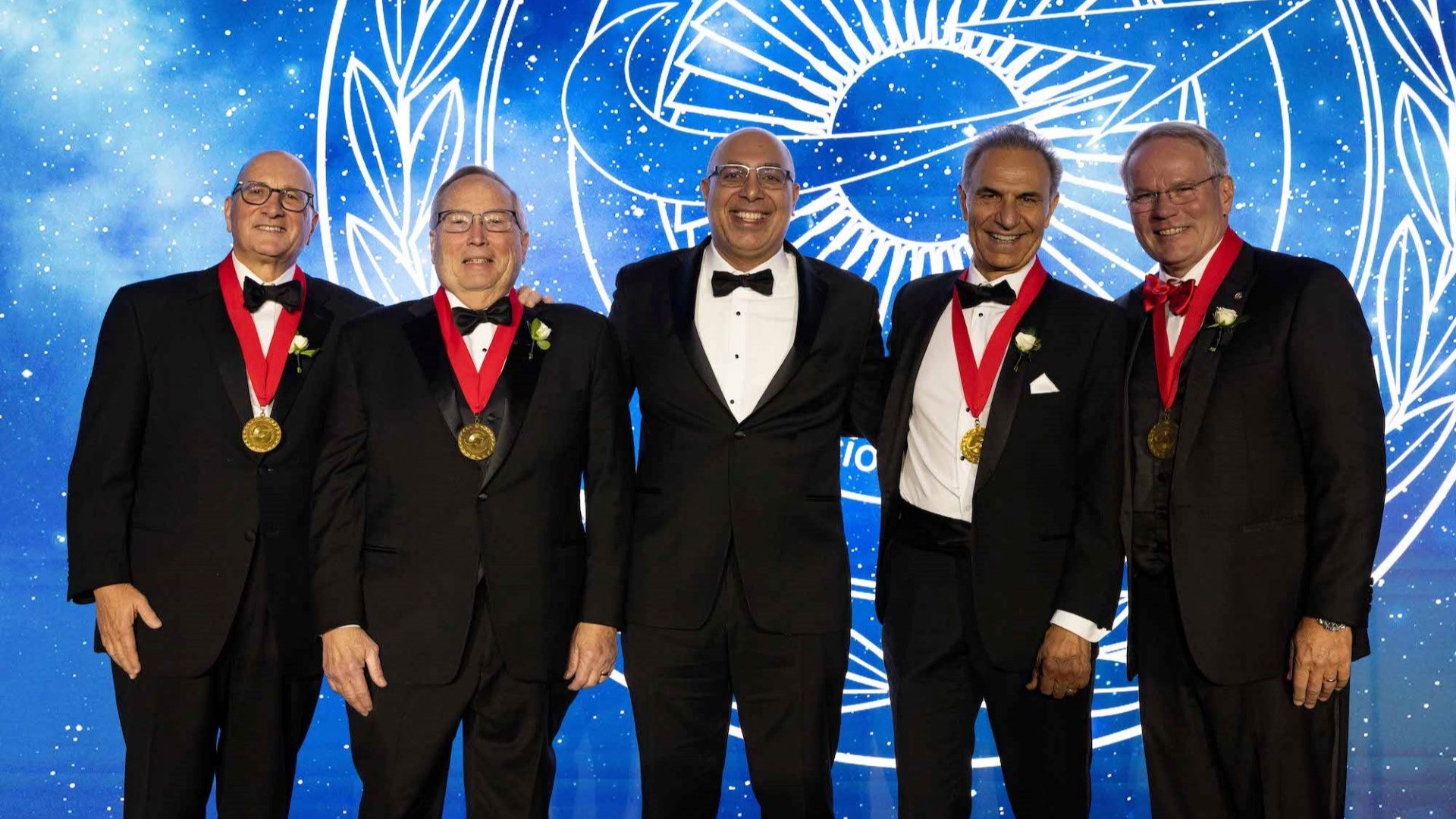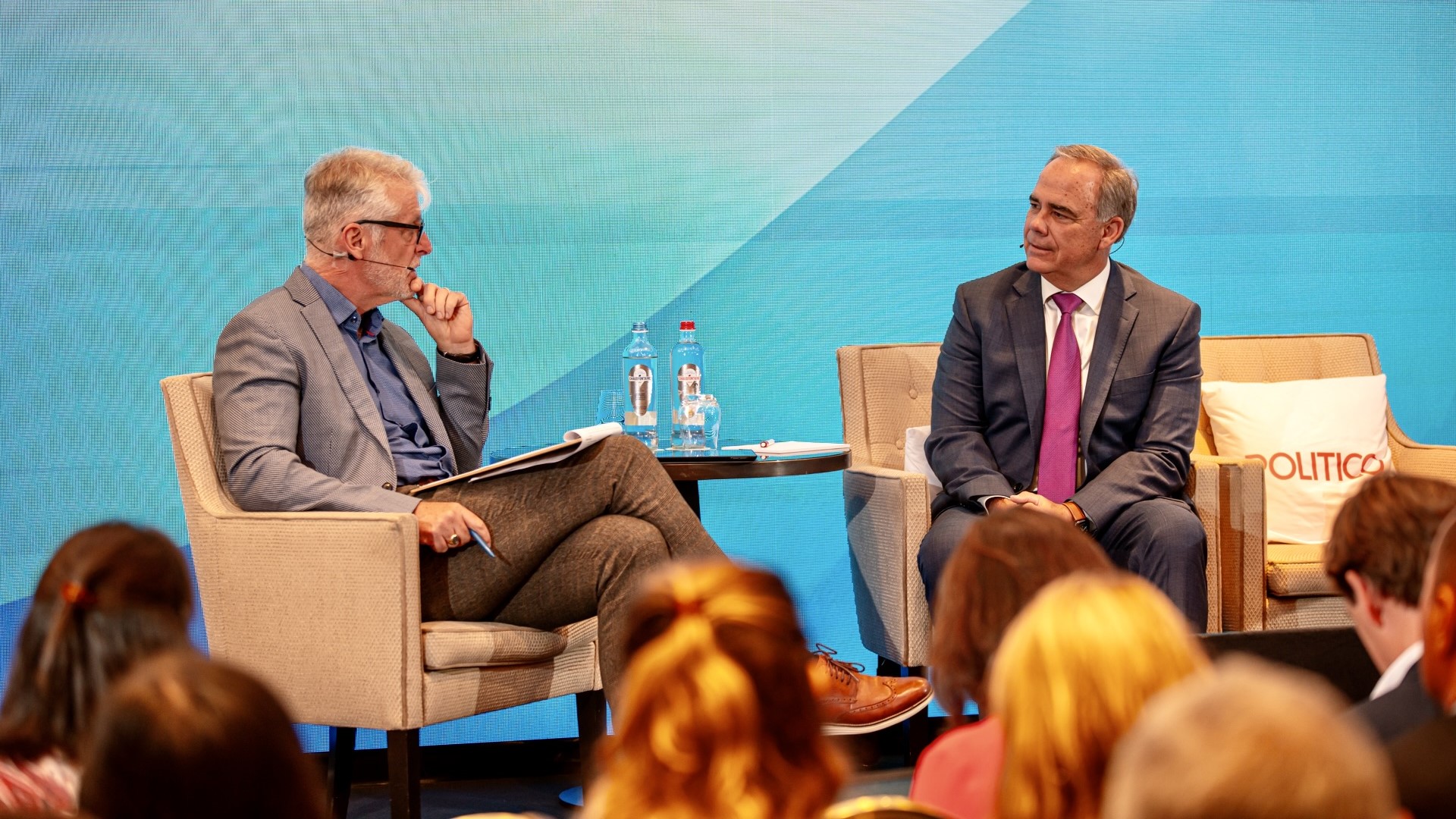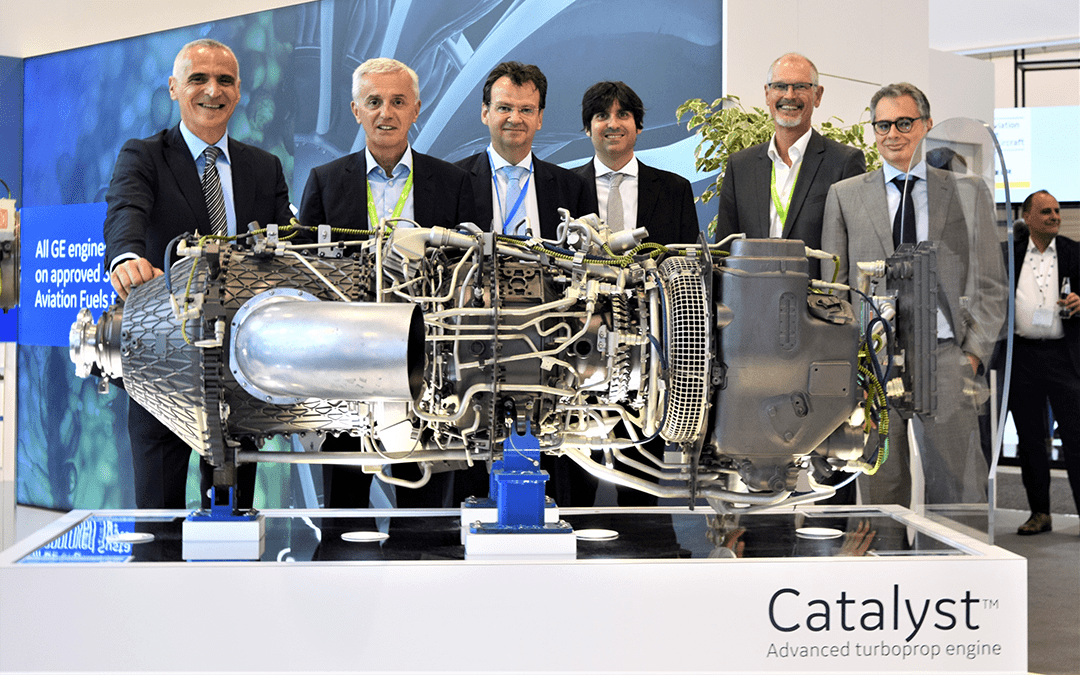The U.S. Enters the Jet Age: Mr. Whitely’s (make that “Whittle”) secret stay in Lynn
February 07, 2019 | by Rick Kennedy
With the world at war in June 1942, a short, fussy Englishman checked into downtown Boston’s Hotel Statler and made a peculiar set of demands.
After registering at the front desk (today’s Boston Park Plaza) as “Mr. Whitely,” he demanded a phone installed in his room not connected to the main switchboard. Meals must be served in his room and delivered by the same bellhop. And please, no surprise knocks on the door.
The mysterious little man was actually Frank Whittle, a 34-year-old Royal Air Force (RAF) officer, pilot, and inventor of the jet engine. Earlier in the year, he nearly suffered a nervous breakdown from exhaustion while racing to bring England, under attack from Germany, into the jet age.
Now, for several weeks in 1942, Whittle was secretly involved in bringing GE’s Lynn, Massachusetts, plant, as well as the U.S.A., into the jet age as well. The course of GE’s new aviation enterprise changed forever.
As a young RAF officer in 1930, Whittle filed for the world’s first turbojet patent application. After facing five years of disinterest from the British government, a London investment house bankrolls Whittle’s commercial venture called Power Jets Ltd., and the RAF allows the young flight officer to work part-time on his propulsion experiments. By 1937, Power Jets is running a turbojet in a test cell.
By May 1941, Europe is at war and Whittle’s turbojet powers England’s experimental Gloster E.28/39 aircraft. The month before, General H.H. “Hap” Arnold, Deputy U.S. Army Chief of Staff for Air, had personally reviewed England’s jet propulsion advances, including the Gloster and its Whittle turbojet. Clearly, U.S. aviation was behind.
Arnold initiated a U.S. jet propulsion program and engaged GE to produce America’s first turbojet using Whittle’s design. His selection of GE was based on the company’s innovative impellers, turbines, turbosuperchargers, and compressors, which were developed mostly in GE’s Lynn and Schenectady operations.
The GE team moved fast. GE’s Supercharger Department in Lynn received a Whittle W.1X turbojet in crates, as well as drawings for an upgraded version, called the Whittle W.2B. A handpicked team in Lynn, nicknamed “The Hush-Hush Boys,” rebuilt the Whittle design, designated the I-A engine.
In 1942, Donald “Truly” Warner, a top Lynn engineer, led the I-A team to reconfigure Whittle’s design to American production standards with several improvements, including a more robust impeller, an automatic control system, and improved metal alloys for more durable turbine blades.
The GE team had a key advantage: The I-A, a centrifugal flow design with a two-sided impeller, was similar to the innovative GE turbosupercharger boosting the piston engines for thousands of U.S. and Allied aircraft.
The GE Lynn team successfully runs the I-A on April 18, 1942, in a concrete test cell dubbed “Fort Knox.” The test cell, with eighteen-inch walls and a distinctive smokestack, is now a historical monument. The first test run occurred about six months after Lynn received drawings for the upgraded Whittle W.2B – a remarkable and patriotic feat by the team.
Then, in June 1942, Whittle in Lynn arrived to lend a hand. He brought updated turbojet drawings and helped to tackle issues with excessive gas exhaust temperatures. Whittle was accompanied by a small group of English engineers. Their stay in the area was equally clandestine.
After several days in the Hotel Statler, Whittle moves in the dark of night into the Marblehead, Massachusetts, home of a GE senior technical leader in Lynn named Reginald Standerwick, a fellow Englishman who joined GE more than 30 years earlier. For several weeks, Whittle will stay in the comfortable two-story house at 17 Brookhouse Drive, which is north of the Lynn plant and a casual walk from the ocean shore.
In the basement, Standerwick and the Lynn technical team held secret meetings with Whittle. His identity was not even revealed to Standerwick’s wife, who years later described him to the Boston Globe: “He [Whittle] had a small moustache and thick brown hair, and he seemed so lonely.”
While testing the engine, GE also works on the XP-59A jet aircraft in tandem with aircraft designer Larry Bell of Bell Aircraft. On October 1, 1942, two I-A engines, each rated at 1,250 pounds of thrust, power the first low-altitude flights of the Bell XP-59A Airacomet at Muroc Dry Lake (today’s Edwards Air Force Base). Bell test pilot Bob Stanley pilots the first flights; the second pilot is Army Colonel Laurence C. Craigie, the first US military pilot to fly a jet-powered airplane.
By then, Whittle was back in England and advancing his turbojets. His efforts lead to the deployment of the first jet aircraft by an Allied nation toward the end of World War II.
But it was a rough ride for Whittle. The British government turned over his technology to the British aerospace industry. His company, Power Jets, was nationalized, which Whittle felt denied him what was his due financial reward. His health became fragile.
By 1948, GE was now at the vanguard of jet propulsion with its J47 axial-low engine, a huge advance from the I-A engine. That same year, Whittle was knighted in England, but soon became ill and retired from the RAF. He immigrated to the U.S. in 1976.
Until his death in 1996, Whittle would heap praise on the U.S. for its strong commitment to his turbojet engine and to the “Hush-Hush Boys” in Lynn for their dedication and ingenuity. He was among the first inductees into the GE Aviation Propulsion Hall of Fame in 1982, a selection which Whittle called “a great honor.”
After registering at the front desk (today’s Boston Park Plaza) as “Mr. Whitely,” he demanded a phone installed in his room not connected to the main switchboard. Meals must be served in his room and delivered by the same bellhop. And please, no surprise knocks on the door.
The mysterious little man was actually Frank Whittle, a 34-year-old Royal Air Force (RAF) officer, pilot, and inventor of the jet engine. Earlier in the year, he nearly suffered a nervous breakdown from exhaustion while racing to bring England, under attack from Germany, into the jet age.
Now, for several weeks in 1942, Whittle was secretly involved in bringing GE’s Lynn, Massachusetts, plant, as well as the U.S.A., into the jet age as well. The course of GE’s new aviation enterprise changed forever.
As a young RAF officer in 1930, Whittle filed for the world’s first turbojet patent application. After facing five years of disinterest from the British government, a London investment house bankrolls Whittle’s commercial venture called Power Jets Ltd., and the RAF allows the young flight officer to work part-time on his propulsion experiments. By 1937, Power Jets is running a turbojet in a test cell.
By May 1941, Europe is at war and Whittle’s turbojet powers England’s experimental Gloster E.28/39 aircraft. The month before, General H.H. “Hap” Arnold, Deputy U.S. Army Chief of Staff for Air, had personally reviewed England’s jet propulsion advances, including the Gloster and its Whittle turbojet. Clearly, U.S. aviation was behind.
 Above: Some of the Hush-Hush Boys with the I-A engine, the first American jet engine. It generated 1,300 pounds of thrust. Image credit: Museum on Innovation and Science Schenectady. Top: Sir Frank Whittle, wearing a hat in the middle, talks to GE engineers. Whittle is recognized as the inventor of the jet engine, along with Germany’s Hans von Ohain. They developed their first prototypes independently in the late 1930s. They did not meet in person until 1966. Whittle was knighted for his work on the jet engine. Image credit: Museum of Innovation and Science Schenectady.
Above: Some of the Hush-Hush Boys with the I-A engine, the first American jet engine. It generated 1,300 pounds of thrust. Image credit: Museum on Innovation and Science Schenectady. Top: Sir Frank Whittle, wearing a hat in the middle, talks to GE engineers. Whittle is recognized as the inventor of the jet engine, along with Germany’s Hans von Ohain. They developed their first prototypes independently in the late 1930s. They did not meet in person until 1966. Whittle was knighted for his work on the jet engine. Image credit: Museum of Innovation and Science Schenectady.
Arnold initiated a U.S. jet propulsion program and engaged GE to produce America’s first turbojet using Whittle’s design. His selection of GE was based on the company’s innovative impellers, turbines, turbosuperchargers, and compressors, which were developed mostly in GE’s Lynn and Schenectady operations.
The GE team moved fast. GE’s Supercharger Department in Lynn received a Whittle W.1X turbojet in crates, as well as drawings for an upgraded version, called the Whittle W.2B. A handpicked team in Lynn, nicknamed “The Hush-Hush Boys,” rebuilt the Whittle design, designated the I-A engine.
In 1942, Donald “Truly” Warner, a top Lynn engineer, led the I-A team to reconfigure Whittle’s design to American production standards with several improvements, including a more robust impeller, an automatic control system, and improved metal alloys for more durable turbine blades.
The GE team had a key advantage: The I-A, a centrifugal flow design with a two-sided impeller, was similar to the innovative GE turbosupercharger boosting the piston engines for thousands of U.S. and Allied aircraft.
The GE Lynn team successfully runs the I-A on April 18, 1942, in a concrete test cell dubbed “Fort Knox.” The test cell, with eighteen-inch walls and a distinctive smokestack, is now a historical monument. The first test run occurred about six months after Lynn received drawings for the upgraded Whittle W.2B – a remarkable and patriotic feat by the team.
Then, in June 1942, Whittle in Lynn arrived to lend a hand. He brought updated turbojet drawings and helped to tackle issues with excessive gas exhaust temperatures. Whittle was accompanied by a small group of English engineers. Their stay in the area was equally clandestine.
After several days in the Hotel Statler, Whittle moves in the dark of night into the Marblehead, Massachusetts, home of a GE senior technical leader in Lynn named Reginald Standerwick, a fellow Englishman who joined GE more than 30 years earlier. For several weeks, Whittle will stay in the comfortable two-story house at 17 Brookhouse Drive, which is north of the Lynn plant and a casual walk from the ocean shore.
 The U.S.'s first jet engine, I-A.
The U.S.'s first jet engine, I-A.
In the basement, Standerwick and the Lynn technical team held secret meetings with Whittle. His identity was not even revealed to Standerwick’s wife, who years later described him to the Boston Globe: “He [Whittle] had a small moustache and thick brown hair, and he seemed so lonely.”
While testing the engine, GE also works on the XP-59A jet aircraft in tandem with aircraft designer Larry Bell of Bell Aircraft. On October 1, 1942, two I-A engines, each rated at 1,250 pounds of thrust, power the first low-altitude flights of the Bell XP-59A Airacomet at Muroc Dry Lake (today’s Edwards Air Force Base). Bell test pilot Bob Stanley pilots the first flights; the second pilot is Army Colonel Laurence C. Craigie, the first US military pilot to fly a jet-powered airplane.
By then, Whittle was back in England and advancing his turbojets. His efforts lead to the deployment of the first jet aircraft by an Allied nation toward the end of World War II.
But it was a rough ride for Whittle. The British government turned over his technology to the British aerospace industry. His company, Power Jets, was nationalized, which Whittle felt denied him what was his due financial reward. His health became fragile.
By 1948, GE was now at the vanguard of jet propulsion with its J47 axial-low engine, a huge advance from the I-A engine. That same year, Whittle was knighted in England, but soon became ill and retired from the RAF. He immigrated to the U.S. in 1976.
Until his death in 1996, Whittle would heap praise on the U.S. for its strong commitment to his turbojet engine and to the “Hush-Hush Boys” in Lynn for their dedication and ingenuity. He was among the first inductees into the GE Aviation Propulsion Hall of Fame in 1982, a selection which Whittle called “a great honor.”





